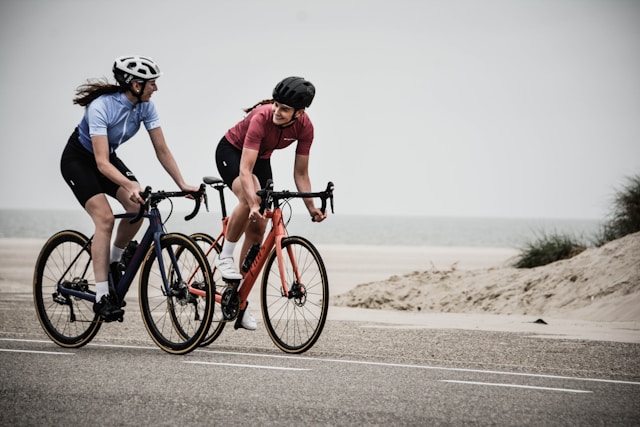Choosing the right bicycle is crucial for comfort, performance, and overall enjoyment. With so many types available, selecting the perfect one can be overwhelming. This guide will help you understand different types of bikes, their intended uses, and how to choose the ideal one based on your needs and riding preferences.
1. Types of Bicycles and Their Purposes
Before buying a bike, it’s essential to know the different types available and their specific uses.
1.1 Road Bikes
- Designed for: Paved roads, long-distance riding, and speed.
- Features: Lightweight frame, thin tires, drop handlebars, and a high gear range.
- Best for: Cyclists who enjoy speed, long rides, or competitive road cycling.
1.2 Mountain Bikes (MTB)
- Designed for: Rough terrains, trails, and off-road cycling.
- Features: Sturdy frame, wide knobby tires, front or full suspension, and powerful brakes.
- Best for: Adventure riders, trail cyclists, and those exploring hilly or rough terrains.
1.3 Hybrid Bikes
- Designed for: A mix of road and off-road cycling.
- Features: Medium-width tires, upright handlebars, comfortable saddle, and a lightweight frame.
- Best for: Commuters, recreational riders, and those who want versatility.
1.4 Gravel Bikes
- Designed for: Mixed surfaces, including gravel, dirt, and pavement.
- Features: Drop handlebars, wider tires than road bikes, and a durable frame.
- Best for: Riders who enjoy long-distance touring with off-road capability.
1.5 Touring Bikes
- Designed for: Long-distance travel with loaded gear.
- Features: Sturdy frame, multiple gears, comfortable saddle, and attachment points for bags.
- Best for: Cyclists who travel with heavy loads over long distances.
1.6 Folding Bikes
- Designed for: Portability and storage convenience.
- Features: Compact, lightweight frame with foldable mechanisms.
- Best for: Urban commuters and travelers who need a bike that fits in small spaces.
1.7 Electric Bikes (E-Bikes)
- Designed for: Assisted pedaling with an electric motor.
- Features: Battery-powered motor, multiple assist levels, and comfortable seating.
- Best for: Commuters, older riders, or those who want an easier ride.
2. How to Choose the Right Bicycle for You
2.1 Determine Your Riding Style
Understanding how and where you plan to ride is the first step in choosing the right bike. Ask yourself:
- Do you prefer smooth city roads or rough trails?
- Is speed a priority, or do you need comfort?
- Will you use the bike for commuting, fitness, or adventure?
2.2 Choose the Right Frame Size
A properly sized bike enhances comfort and control. Bike frames are measured in inches or centimeters, and size recommendations depend on your height. Visit a local bike shop to test different sizes or refer to manufacturer sizing charts.
2.3 Consider the Gear System
- Single-speed bikes are ideal for flat terrain and simple riding.
- Multi-gear bikes help with climbing hills and riding in various conditions.
- Derailleur gears are common in road and mountain bikes for smooth shifting.
If you ride in hilly areas, a bike with a wider gear range will be beneficial.
2.4 Suspension Options
- No suspension (Rigid bikes) – Common in road, hybrid, and gravel bikes for smooth surfaces.
- Front suspension (Hardtail bikes) – Found in mountain bikes for absorbing impact on rough trails.
- Full suspension (Dual suspension bikes) – Ideal for extreme off-road riding with maximum shock absorption.
2.5 Select the Right Tires
- Thin tires (23-28mm) – Best for road bikes, offering speed and efficiency.
- Medium-width tires (30-50mm) – Found in hybrid and gravel bikes, balancing comfort and grip.
- Wide knobby tires (2.0-2.5 inches) – Designed for mountain bikes, providing better traction on rough terrain.
2.6 Weight and Material of the Frame
- Aluminum – Lightweight, affordable, and corrosion-resistant.
- Steel – Durable and comfortable but heavier.
- Carbon Fiber – Ultra-lightweight and strong, ideal for high-performance bikes but more expensive.
2.7 Additional Features to Consider
- Brakes – Disc brakes provide better stopping power than rim brakes, especially in wet conditions.
- Handlebars – Drop handlebars (for speed) vs. flat handlebars (for comfort).
- Accessories – Fenders, racks, lights, and bottle holders enhance convenience.
3. Final Tips for Buying the Perfect Bike
3.1 Set a Budget
Bicycles range from budget-friendly options to high-end performance models. Set a realistic budget based on your needs and the features that matter most.
3.2 Test Ride Before Buying
A test ride helps you assess comfort, fit, and handling. If buying online, ensure the retailer has a return or exchange policy.
3.3 Research Brands and Reviews
Trusted brands like Trek, Giant, Cannondale, and Specialized offer reliable quality. Read customer reviews and expert recommendations before making a final decision.
3.4 Consider Maintenance and Repairs
Regular maintenance extends your bike’s lifespan. Ensure that replacement parts are easily available and consider learning basic bike maintenance, such as fixing a flat tire or adjusting gears.
Conclusion
Selecting the perfect bicycle depends on your riding style, terrain, and personal preferences. Whether you need a road bike for speed, a mountain bike for adventure, or a hybrid for commuting, understanding key features will help you make an informed choice. Take your time, test different models, and invest in a bike that suits your needs for years of enjoyable riding.



